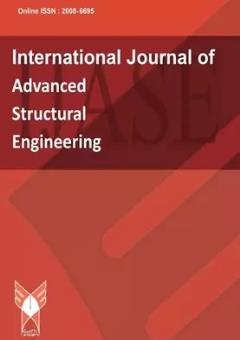Effect of Shear Connector Height on the Shear Performance of Y-shaped Connectors in Steel–Concrete Composite Beams
محورهای موضوعی : Structural Engineering in Energy-Efficient Buildingsmaede davami 1 , alireza mirza goltabar roshan 2 , Hamidreza Tavakoli 3
1 - 1 Department of Civil Engineering, Babol Noshirvani University of Technology (NIT), Babol, Mazandaran, Iran)
2 - دانشگاه صنعتی نوشیروان بابل، دانشکده مهندسی عمران
3 - Babol Noshirvani University of Technology
کلید واژه: Y-shaped shear connector, connector height, composite beam, finite element analysis, shear strength, ductility, ABAQUS simulation,
چکیده مقاله :
This paper investigates the influence of connector height on the shear behavior of Y-shaped shear connectors in steel–concrete composite beams. A three-dimensional nonlinear finite element (FE) model was developed using ABAQUS 6.14 to simulate push-out tests. The model incorporated nonlinear constitutive behavior of concrete and steel, surface-to-surface contact interaction, and displacement-controlled loading. Connector heights of 30, 40, 50, 60, and 70 mm were analyzed, while width (30 mm), rebar diameter (12 mm), and concrete strength (30 MPa) were kept constant. The model was validated against experimental results by Kim et al., demonstrating excellent agreement in terms of load–slip response and ultimate shear strength. The results revealed that increasing connector height enhances shear capacity and stiffness up to approximately 50 mm. Beyond this limit, the improvement becomes marginal, and ductility decreases due to concrete cracking at the connector base. Stress contour analysis confirmed that excessive height promotes localized tensile stresses and brittle failure near the interface. The study concludes that an optimal connector height of 50–55 mm provides the best compromise between strength, stiffness, and ductility. The findings contribute to the improved design of composite beams under monotonic shear loading.
This paper investigates the influence of connector height on the shear behavior of Y-shaped shear connectors in steel–concrete composite beams. A three-dimensional nonlinear finite element (FE) model was developed using ABAQUS 6.14 to simulate push-out tests. The model incorporated nonlinear constitutive behavior of concrete and steel, surface-to-surface contact interaction, and displacement-controlled loading. Connector heights of 30, 40, 50, 60, and 70 mm were analyzed, while width (30 mm), rebar diameter (12 mm), and concrete strength (30 MPa) were kept constant. The model was validated against experimental results by Kim et al., demonstrating excellent agreement in terms of load–slip response and ultimate shear strength. The results revealed that increasing connector height enhances shear capacity and stiffness up to approximately 50 mm. Beyond this limit, the improvement becomes marginal, and ductility decreases due to concrete cracking at the connector base. Stress contour analysis confirmed that excessive height promotes localized tensile stresses and brittle failure near the interface. The study concludes that an optimal connector height of 50–55 mm provides the best compromise between strength, stiffness, and ductility. The findings contribute to the improved design of composite beams under monotonic shear loading.
1. Kodur, V., M. Dwaikat, and R. Fike, High-temperature properties of steel for fire resistance modeling of structures. Journal of Materials in Civil Engineering, 2010. 22(5): p. 423-434.
2. Kim, S.-H., et al., Analysis of the shear behavior of stubby Y-type perfobond rib shear connectors for a composite frame structure. Materials, 2017. 10(11): p. 1340.
3. Kim, S.-H., et al., Comparison of hysteretic performance of stubby Y-type perfobond rib and stud shear connectors. Engineering Structures, 2017. 147: p. 114-124.
4. Ahn, J.-H., et al., Shear resistance of the perfobond-rib shear connector depending on concrete strength and rib arrangement. Journal of Constructional Steel Research, 2010. 66(10): p. 1295-1307.
5. Kim, S.-H., et al., Experimental shear resistance evaluation of Y-type perfobond rib shear connector. Journal of constructional steel research, 2013. 82: p. 1-18.
6. He, J., et al., Shear behavior and damage identification of π-shaped demountable connector for composite beam equipped with acoustic emission sensors. Construction and Building Materials, 2025. 497: p. 143811.
7. Oguejiofor, E. and M. Hosain, Behaviour of perfobond rib shear connectors in composite beams: full-size tests. Canadian Journal of Civil Engineering, 1992. 19(2): p. 224-235.
8. Hong, S. and A.H. Varma, Analytical modeling of the standard fire behavior of loaded CFT columns. Journal of Constructional Steel Research, 2009. 65(1): p. 54-69.
9. Kim, K.-S., et al., Numerical simulation of Y-type perfobond rib shear connectors using finite element analysis. Steel Compos. Struct, 2019. 31(1): p. 53-67.


